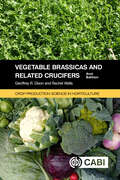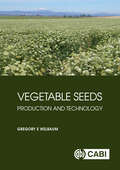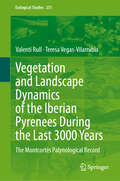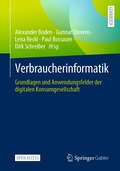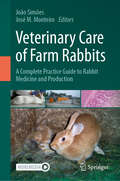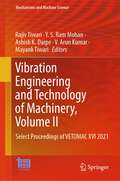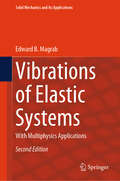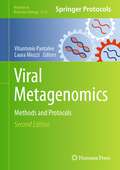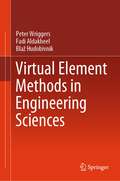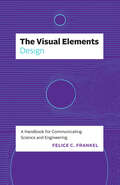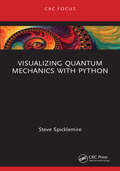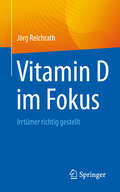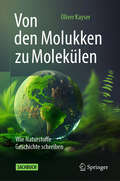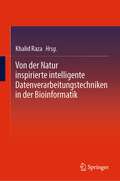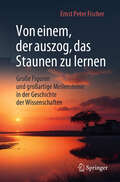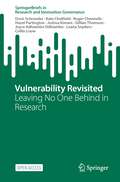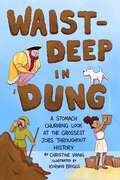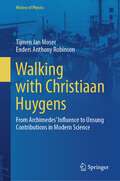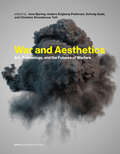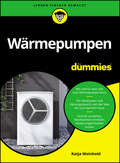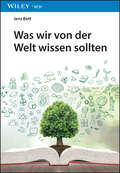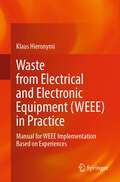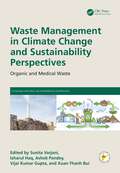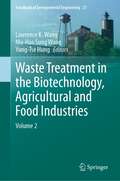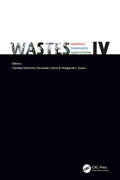- Table View
- List View
Vegetable Brassicas and Related Crucifers (Crop Production Science in Horticulture)
by Geoffrey Dixon Dr Rachel WellsThe Brassica genus contains diverse and economically important species and crops, for example, Brassica oleracea including cauliflower to kohlrabi, B.rapa including pak choi to mizuna, and aquatic crucifers such as watercress. These provide humankind with huge diversities of foods, promoting health and well-being. This substantially expanded second edition reflects the significant advances in knowledge of plant breeding and crop production which have occurred since publication of the original book in 2006. Embracing new Brassicaceae research and concepts of sustainable and automated crop production, topics include: Brassica evolution and transcontinental spread as the basis for crop breeding Gene-editing, rapid sequencing, genetic markers and linkage mapping to enable efficient plant breeding Seed development, F1 cultivars and rapid maturing crops for profitable cropping Environmental impacts on pests, pathogens, crop reliability and quality Soil health and fertility as agronomic principles Environmental sustainability, biocontrol and integrated pest management Vegetable brassicas as nutrient-rich foods for optimal health benefits An invaluable resource for all those involved in Brassica production, this is essential reading for researchers and students in horticulture and plant science, growers, producers, consultants and industry advisors.
Vegetable Seeds: Production and Technology
by Gregory E WelbaumMost food and fiber crops are produced from seed. This means that the world's population is dependent on annual seed production for its food supply. Vegetable seed production is much different and more challenging than production of grain crops. This book explains the biology and technology behind producing, maintaining, and enhancing the quality of vegetable seeds from breeding through to the marketed product. It begins with six chapters on a broad range of seed-related topics: the importance of seeds, reproductive biology of plants, genetic improvement strategies, quality assurance of seed production, post-harvest seed enhancement, and organic production. The remaining chapters cover seed production in eleven important vegetable families. Each chapter provides a description of the botany, types and cultivars, genetic improvement, pollination, soil fertility management, pest management, crop production, harvesting, post-harvest handling, and seed yields. The aim of this book is to educate how to produce high-quality vegetable seeds. Incorporating both current methodologies and recent research results, it is suitable for students, researchers, and professionals in the seed industry.
Vegetation and Landscape Dynamics of the Iberian Pyrenees During the Last 3000 Years: The Montcortès Palynological Record (Ecological Studies #251)
by Valentí Rull Teresa Vegas-VilarrúbiaThe high-resolution palynological study of the varved sediments of Lake Montcortès has provided a unique record of the regional vegetation shifts over the last 3000 years and of the natural and anthropogenic drivers of ecological change, unparalleled in the Mediterranean. This book shows in detail how the terrestrial ecosystems of Montcortès have responded to climatic events such as the Medieval Climate Anomaly or the Little Ice Age, as well as to varying intensities of anthropogenic pressure from the Bronze Age to the present. The knowledge gained from this palaeoecological study is useful not only for understanding how the modern landscapes of the Pyrenees were shaped, but also for conserving biodiversity and ecosystems in the face of future environmental changes related to ongoing global change. The book is aimed at researchers, university teachers and advanced graduate students in a wide range of disciplines including ecology, palaeoecology, environmental science, biodiversity, geography, sedimentology, archaeology, anthropology, and biodiversity conservation.
Verbraucherinformatik: Grundlagen und Anwendungsfelder der digitalen Konsumgesellschaft
by Alexander Boden Gunnar Stevens Lena Recki Paul Bossauer Dirk SchreiberIn einer Zeit, in der digitale Technologien nahezu jeden Aspekt unseres Lebens durchdringen, ist es unerlässlich, die tieferen Zusammenhänge des digitalen Konsums zu verstehen. Erstmalig bietet dieses open access-Lehrbuch einen Wegweiser durch die vielfältigen Facetten der Digitalisierung des Konsums. Dabei verbindet es die Disziplinen der angewandten Informatik und Verbraucherwissenschaften. Die Leserinnen und Leser erhalten Einblick in die digitale Konsumlandschaft, ausgehend von der historischen Entwicklung des (digitalen) Konsums. Dazu vermittelt das Lehrbuch zentrale Grundbegriffe und Themen der Verbraucherinformatik und stellt verschiedene Konsumtheorien aus den Disziplinen Wirtschaftswissenschaften, Psychologie und Sozialwissenschaften vor. Praxisnahe Beispiele aus der Digitalisierung bieten Einsichten in unterschiedliche Perspektiven, während vertiefende Textboxen und Selbstreflexionsfragen das Verständnis fördern. Inhaltlich decken die Autorinnen und Autoren Themen von Datenschutz bis zur Sharing Economy ab und geben insbesondere auch praktische Ansätze für Themen wie Verbraucherschutz und Nachhaltigkeit mit auf den Weg. Die Anwendungs- und Querschnittsthemen der Verbraucherinformatik reichen von der Digitalisierung der Haushalte und Märkte über Fragen des digitalen Verbraucherschutzes bis hin zu zentralen gesellschaftlichen Fragestellungen rund um die Themen Fairness, Verantwortung und Nachhaltigkeit bei der Gestaltung von digitalen Technologien. Das Buch bietet einen umfassenden Überblick, der sowohl für Studierende der Wirtschafts- und Sozialwissenschaften als auch der angewandten Informatik von bedeutendem Wert ist.
Veterinary Care of Farm Rabbits: A Complete Practice Guide to Rabbit Medicine and Production
by João Simões José M. MonteiroThis holistic guide brings rabbit production science and medicine together. It considers the full spectrum of commercial rabbit husbandry, including intensive, semi-intensive, and organic systems for meat, fur and leather. Drawn from an international authorship, the book addresses practical and fundamental topics. In comprehensive sections, readers will find easy-to-read chapters on:• rabbit breeds, anatomy essentials and lagomorph physiology• rabbit production with details on animal facilities and farm design, international trading, rabbit meat processing and biosafety, including a vivid appendix on meat inspection• rabbit herd and health management, considering latest findings in welfare and behavior, preventive medicine, antimicrobial resistance and demedication to necropsy and specimen collection• significant rabbit diseases, covering encephalitozoonosis cuniculi, rabbit enteropathies, and many more• complete veterinary treatment, supplemented by reference ranges and interpretation of hematological and biochemical valuesBesides an increasing keeping of pet rabbits, the animals are gaining interest for sustainable food production, leading to a rise in farming in various parts of the world. In this context, the present guide provides valuable contributions for consulting veterinarians and students, industry professionals, breeders and technicians, as well as for experts from the small and companion animal sector.The relevance of rabbit farming from the viewpoints of greenhouse gas reduction and sustainable use of ecological resources (use of local feed) also creates useful links for readers interested in the sustainable development goals SDG 2 (Zero Hunger) and SDG 12 (Responsible Consumption and Production).
Vibration Engineering and Technology of Machinery, Volume II: Select Proceedings of VETOMAC XVI 2021 (Mechanisms and Machine Science #153)
by Rajiv Tiwari Y. S. Ram Mohan Ashish K. Darpe V. Arun Kumar Mayank TiwariThis book presents the proceedings of the XVI International Conference on Vibration Engineering and Technology of Machinery (VETOMAC 2021). It gathers the latest advances, innovations, and applications in the field of vibration and technology of machinery. Topics include concepts and methods in dynamics, dynamics of mechanical and structural systems, dynamics and control, condition monitoring, machinery and structural dynamics, rotor dynamics, experimental techniques, finite element model updating, industrial case studies, vibration control and energy harvesting, and MEMS. The contributions, which were selected through a rigorous international peer-review process, share exciting ideas that will spur novel research directions and foster new multidisciplinary collaborations. The book is useful for the researchers, engineers and professionals working in the area of vibration engineering and technology of machinery.
Vibrations of Elastic Systems: With Multiphysics Applications (Solid Mechanics and Its Applications #184)
by Edward B. MagrabThis book presents new topics such as Inerters in spring-mass models and attached to beams; fluid loading on beams, plates, and shells; bio-inspired vibration isolation and absorption; coupled bending and torsion of beams; beams with functionally graded materials; as well as a new chapter on the Mindlin/Timoshenko plate theory: rectangular and circular. New applications and enhancements to the previous edition include moving mass on beams; thin beams with attached pendulum; transient response of beams with in-span attachments; and shells to model blood flow in arteries.
Viral Metagenomics: Methods and Protocols (Methods in Molecular Biology #2732)
by Vitantonio Pantaleo Laura MiozziThis second edition volume expands on the previous edition with discussions about the latest viral metagenomics aspects covering a range of different specimens such as soil, freshwater, wastewater, fecal samples, blood plasma, clinical tissues, fungi, and herbarium samples. Chapters also look at different viral groups including archaeal viruses, eukaryotic viruses, phages, mycoviruses, and circular DNA viruses. Techniques required for studying the three viral metagenomic steps of samples processing, library construction, and analysis of data are also discussed. Written in the highly successful Methods in Molecular Biology series format, chapters include introductions to their respective topics, lists of the necessary materials and reagents, step-by-step, readily reproducible laboratory protocols, and tips on troubleshooting and avoiding known pitfalls.Authoritative and cutting-edge, Vital Metagenomics: Methods and Protocols, Second Edition is a valuable resource for researchers who are interested in learning more about this important and developing field.
Virtual Element Methods in Engineering Sciences
by Peter Wriggers Fadi Aldakheel Blaž HudobivnikThis book provides a comprehensive treatment of the virtual element method (VEM) for engineering applications, focusing on its application in solid mechanics. Starting with a continuum mechanics background, the book establishes the necessary foundation for understanding the subsequent chapters. It then delves into the VEM's Ansatz functions and projection techniques, both for solids and the Poisson equation, which are fundamental to the method. The book explores the virtual element formulation for elasticity problems, offering insights into its advantages and capabilities. Moving beyond elasticity, the VEM is extended to problems in dynamics, enabling the analysis of dynamic systems with accuracy and efficiency. The book also covers the virtual element formulation for finite plasticity, providing a framework for simulating the behavior of materials undergoing plastic deformation. Furthermore, the VEM is applied to thermo-mechanical problems, where it allows for the investigation of coupled thermal and mechanical effects. The book dedicates a significant portion to the virtual elements for fracture processes, presenting techniques to model and analyze fractures in engineering structures. It also addresses contact problems, showcasing the VEM's effectiveness in dealing with contact phenomena. The virtual element method's versatility is further demonstrated through its application in homogenization, offering a means to understand the effective behavior of composite materials and heterogeneous structures. Finally, the book concludes with the virtual elements for beams and plates, exploring their application in these specific structural elements. Throughout the book, the authors emphasize the advantages of the virtual element method over traditional finite element discretization schemes, highlighting its accuracy, flexibility, and computational efficiency in various engineering contexts.
The Visual Elements—Design: A Handbook for Communicating Science and Engineering (The Visual Elements)
by Felice C. FrankelWith insights and examples from designers at publications from Nature to the New York Times, an essential guide to creating figures and presentations. In this short handbook, award-winning science communicator Felice C. Frankel offers a quick guide for scientists and engineers who want to share—and better understand—their research by designing compelling graphics for journal submissions, grant applications, presentations, and posters. Like all the books in the Visual Elements series, this handbook is also a training tool for researchers. Distilling her celebrated books and courses to the essentials, Frankel shows scientists and engineers, from students to primary investigators, the importance of thinking visually. This crucial volume in the Visual Elements series offers a wealth of engaging design examples. Case studies and advice from designers at prestigious publications and researchers’ own before-and-after examples show how even the smallest changes—to color, type, composition, and layering—can greatly improve communication. Ideal for researchers who want a foothold for presenting and preparing their work for everything from conferences to publications, the book explains the steps for creating a concise and communicative graphic to highlight the most important aspects of research—and to clarify researchers’ own thinking. The resulting book is an essential element of any scientist’s, engineer’s, or designer’s library.
Visualizing Quantum Mechanics with Python
by Steve SpicklemireQuantum Mechanics can be an abstract and complex subject. Students often complain of confusion, struggle, and frustration as they try to master the topic. The goal of this book is to reduce the complexity and clarify the abstractions with concrete visual examples driven by simple python programs. It is assumed that the reader is concurrently taking a course in quantum mechanics, or self-studying quantum mechanics, but is looking for supplementary material to help with understanding and visualizing how quantum mechanics works.The focus of this book is writing python programs to visualize the underlying behavior of the mathematical theory. The background needed to understand quantum mechanics is differential equations, linear algebra and modern physics. We need a strong foundation in differential equations and linear algebra because the behavior of quantum systems is governed by equations that are written in terms of these concepts. Modern physics includes concepts such as special relativity and quantum phenomena like the photoelectric effect and energy quantization that the theory of quantum mechanics seeks to explain. This book is also not an introduction to the python programming language, or to numpy, or even to VPython. However its programming examples start simply and grow more complex as the chapters progress, so deep expertise in any of these is not a pre-requisite.Key features:· Provides an accessible and practical guide to the abstractions in quantum mechanics with concrete visual examples driven by simple python programs.· Contains few derivations, equations, and proofs.· For complete beginners of python programming, appendix B serves as a very brief introduction to the main concepts needed to understand the code in this book.Dr. Stephen Spicklemire is Associate Professor of Physics at the University of Indianapolis, USA. He has been teaching physics at the University of Indianapolis for more than 30 years. From the implementation of "flipped" physics class to the modernization of scientific computing and laboratory instrumentation courses, he has brought the strengths of his background in physics, engineering and computer science into the classroom. Dr. Spicklemire also does IT and engineering consulting. He is an active participant in several national research initiatives relating to improving physics education. These range from improving materials to help students prepare for class, to supporting students success through standards based grading. He is an active developer of the VPython and WebVPython projects and a contributor to the Matter and Interactions textbook.
Vitamin D im Fokus: Irrtümer richtig gestellt
by Jörg ReichrathWelchen Einfluss hat Vitamin D auf die Entstehung von Krebserkrankungen, Herz-Kreislauferkrankungen, Stoffwechsel- und Autoimmunerkrankungen? Wie gelingt die Balance zwischen notwendiger Sonneneinstrahlung und Vermeidung des Hautkrebsrisikos? Antworten auf diese und viele weitere Fragen zu diesem wichtigen Vitamin sowie der Vitamin D Mangelerkrankung Rachitis liefert das vorliegende Werk. Es räumt dabei mit häufigen Irrtümern über Aufbau, Funktion und Wirkung von Vitamin D auf und liefert darüber hinaus zahlreiche, praxisrelevante Fakten für eine optimale Versorgung. Der Autor ist ausgewiesener Experte auf dem Gebiet und seit über drei Jahrzehnten in der Forschung zu Vitamin D tätig. Das Buch wendet sich an Ärztinnen und Ärzte, die ihre Patientinnen und Patienten auf Basis neuester wissenschaftlicher Erkenntnisse rund um das Thema Vitamin D bestmöglich versorgen und informieren möchten.
Von den Molukken zu Molekülen: Wie Naturstoffe Geschichte schreiben
by Oliver KayserNaturstoffe sind ein Wunderwerk der Evolution. Pflanzen sind chemische Fabriken und haben mit ihren außergewöhnlichen Eigenschaften eine riesige Anzahl sehr vielfältiger interessanter Naturstoffe hervorgebracht, die wir Menschen seit Jahrhunderten zur Linderung und Heilung von Krankheiten nutzen. Spätestens seit der Entdeckung des Penicillins sind Naturstoffe zu einer wichtigen Quelle für Medikamente geworden, aber wir kennen nur sehr wenige der vermutlich vielen Millionen, die auf ihre Entdeckung warten. Zu den Naturstoffen gehören wichtige Antibiotika, Immunsuppressiva, Antikrebsmittel, Hormone und auch antivirale Wirkstoffe. Aber haben Naturstoffe im Zeitalter der Bio- und Gentechnologie überhaupt noch eine Bedeutung? Ja, mehr denn je, denn Medizinalchemiker holen sich kreative Anregungen für ihre Synthesen aus der Natur, um den nächsten Blockbuster in der Medizin zu entwickeln. Oliver Kayser erzählt in diesem Buch die Geschichte der Naturstoffe und Medizinpflanzen auf höchst informative und amüsante Weise aus einem neuen Blickwinkel. Er geht der Frage nach, wie Naturstoffe aus der Naturheilkunde die pharmazeutische Industrie ins Leben riefen, wie sie als Arznei- und Heilmittel unsere Gesellschaft prägten, wie sie Kriege ermöglichten und den Weg zu Nobelpreisen ebneten. Der Autor zeichnet ein faszinierendes Panorama der Naturstoffchemie in Pflanzen, Mikroorganismen und Tieren. Beginnend mit den ersten Isolierungen zu Anfang der industriellen Revolution führt er uns mit den Ideen und der Begeisterung vieler Wissenschaftlerinnen und Wissenschaftler in die Moderne der Wirkstofftests, der Computerchemie und der höchst erfolgreichen Zufallsentdeckungen von Wirkstoffen. Die Naturstoffforschung im Labor hat einen enormen Einfluss auf unser heutiges Leben. Der Autor lässt sich über die Schulter schauen, wie heute die Suche nach den neuen Medikamenten von morgen funktioniert. Das Buch ist das ultimative Buch aus der Feder eines Wissenschaftlers, der tief in der Forschung verwurzelt ist und dem Leser einen erhellenden und zugleich kurzweiligen Einblick gibt, wie Wissenschaftler ticken und wie mühsam Forschung sein kann.
Von der Natur inspirierte intelligente Datenverarbeitungstechniken in der Bioinformatik
by Khalid RazaDieses Buch umfasst und beschäftigt sich mit den jüngsten Fortschritten und modernsten Anwendungen von naturinspirierten Computertechniken (NIC) im Bereich der Bioinformatik und der Computerbiologie, die die medizinischen Wissenschaften bei verschiedenen klinischen Anwendungen unterstützen können. Dieser Sammelband befasst sich mit den grundlegenden Anwendungen, dem Umfang und den Zukunftsperspektiven von NIC-Techniken in der Bioinformatik, einschließlich der Erstellung von Genomprofilen, der Klassifizierung von Genexpressionsdaten, der DNA-Berechnung, der System- und Netzwerkbiologie, der Lösung von Komplikationen bei personalisierten Therapien, der antimikrobiellen Resistenz bei bakteriellen Krankheitserregern und der computergestützten Entwicklung von Arzneimitteln, deren Entdeckung und Therapie. Darüber hinaus wird die Rolle von NIC-Techniken bei verschiedenen Krankheiten und Störungen behandelt, einschließlich Krebserkennung und -diagnose, Brustkrebs, Erkennung von Lungenkrankheiten, Krankheits-Biomarkern und Identifizierung potenzieller Therapeutika.
Von einem, der auszog, das Staunen zu lernen: Große Figuren und großartige Meilensteine in der Geschichte der Wissenschaften
by Ernst Peter Fischer„Wer sich nicht mehr wundern und nicht mehr staunen kann, der ist sozusagen tot und sein Auge erloschen“, hat Albert Einstein einmal geschrieben, und diese Worte haben einen Knaben ermutigt, sich in die Welt der Wissenschaft zu begeben, um hier das Staunen zu lernen. Er wollte und will mit den Wundern der Wissenschaft leben, die den Menschen das Dasein erleichtert und ihr Weltbild ausschmückt. Aus seinem Leben wird hier erzählt und wie er sich in diese faszinierende Sphäre des Geistes hineinträumt. Dabei entsteht ein Roman der Naturwissenschaften, der von den Überraschungen im Innersten der Dinge handelt, die dort zu erleben sind und sich auf die Bedingungen der menschlichen Existenz auswirken. Der Roman stellt in persönlichen Begegnungen und Gesprächen Akteure auf dem Feld der Forschung vor, die nicht nur den Atomen, sondern zum Beispiel auch dem Geheimnis des Lebens und dem Erwachen der Intelligenz auf die Spur gekommen sind und heute versuchen, Maschinen damit auszustatten. Man versteht die Gegenwart besser, wenn man die historischen Erfolge der Wissenschaften kennt, die den modernen Alltag mit digitalen Medien dominieren und auf Fragen zum Klimawandel und zur Energieversorgung antworten können. In diesem Buch kann man beginnen, das zum Verstehen führende Staunen zu lernen, mit dem die Menschheit ihren eingangs von Einstein befürchteten Tod vermeiden und die Welt erleben kann.Ernst Peter Fischer beleuchtet spannend und unterhaltsam die Geschichte der Naturwissenschaft und ihrer Akteure.
Vulnerability Revisited: Leaving No One Behind in Research (SpringerBriefs in Research and Innovation Governance)
by Doris Schroeder Roger Chennells Kate Chatfield Hazel Partington Joshua Kimani Gillian Thomson Joyce Adhiambo Odhiambo Leana Snyders Collin LouwOpen access. This open-access book discusses vulnerability and the protection-inclusion dilemma of including those who suffer from serious poverty, severe stigma, and structural violence in research. Co-written with representatives from indigenous peoples in South Africa and sex workers in Nairobi, the authors come down firmly on the side of inclusion. In the spirit of leaving no one behind in research, the team experimented with data collection methods that prioritize research participant needs over researcher needs. This involved foregoing the collection of personal data and community researchers being involved in all stages of the research. In the process, the term ‘vulnerability’ was illuminated across significant language barriers as it was defined by indigenous peoples and sex workers themselves. The book describes a potential alternative to exclusion from research that moves away from traditional research methods. By ensuring that the research is led by vulnerable groups for vulnerable groups, it offers an approach that fosters trust and collaboration with benefits for the community researchers, the wider community as well as research academics. Those living in low-income settings, in dire situations that are summarized with the term ‘vulnerability’ know best what their problems are and which priorities they have. To exclude them from research for their own protection is a patronizing approach which insinuates that researchers and research ethics committees know best. The team from this book have shown that minimally risky and minimally burdensome research tailored towards the needs of highly marginalized and stigmatized communities can be scientifically valuable as well as inclusive and equitable. I congratulate them. Prof. Klaus Leisinger, President Global Values Alliance, Former personal advisor to Kofi Annan on corporate responsibility
Waist-Deep in Dung: A Stomach-Churning Look at the Grossest Jobs Throughout History (Dung for Dinner #2)
by Christine VirnigA hilarious illustrated middle-grade nonfiction offering about the most revolting jobs throughout history involving pee, poop, vomit, dead bodies, and all things disgusting, from Christine Virnig and Korwin Briggs, the author-illustrator team behind SCBWI Golden Kite Finalist Dung for Dinner.What did the ancient Egyptian embalmer say when he was feeling sad? I want my mummy!After wading into the grossest animal pee, poop, and vomit humans have consumed in Dung for Dinner, Dr. Virnig dives back into the muck with an equally humorous and informative exploration of the most revolting jobs throughout history in Waist-Deep in Dung.From the ancient Egyptian mummy makers who removed brains by shoving iron hooks up peoples’ noses, to the 19th century Toshers who hunted for treasure deep in the London sewers, to modern day forensic entomologists who study the fly eggs, maggots, and other creepy crawlies that live on—and crawl through—human corpses, we'll learn about jobs that deal with poop, pee, blood, medicine, and dead bodies. Combining history, science, and a slew of fascinating facts, it’s middle grade nonfiction with real kid appeal. Art from Korwin Briggs will make readers laugh out loud!
Walking with Christiaan Huygens: From Archimedes' Influence to Unsung Contributions in Modern Science (History of Physics)
by Tijmen Jan Moser Enders Anthony RobinsonDutch scientist Christiaan Huygens (1629-1695) left an indelible mark on the fields of mathematics, physics, astronomy, and geophysics. Despite his groundbreaking contributions, history has often overlooked his pivotal role. While two of the most famous achievements in physics are Newton’s theory of gravity and Einstein’s general theory of relativity, less well-known is that Huygens provided central elements to these theories. This book stands to correct that deficit. For example, we show how Huygens used symmetry arguments to derive conservation laws for momentum and for energy, and what Einstein later called the principle of equivalence to derive the formula for centrifugal force. In 1689, Huygens visited Newton. Together, they walked the streets of London. Newton had recently finished his masterpiece, Principia, expounding his laws of motion and the law of universal gravitation. Huygens had essentially completed his life’s work by then, building on Archimedes, Leonardo da Vinci, Galileo, Descartes, Fermat, Pascal and his own ingenuity. He had established fame as an instrument maker (telescope, pendulum clock, planetarium). He had invented the 31 tone system. He had pioneered the first principles of remote sensing. He had discovered the rings of Saturn. He had formulated the wave theory of light. What would walking with Christiaan reveal? This book gives the result in nine chapters, namely: spontaneous order, the speed of light, Huygens’ principle, the telescope, the pendulum clock, Huygens-Fresnel principle, special relativity, centrifugal force, and curvature. In addition, there is a chapter titled What Huygens could have written on diffraction, and a chapter titled Huygens and Geophysics. Mentally walking with Christiaan, browsing his collected works — a true treasure trove for puzzle enthusiasts — and rethinking his ideas creates a vivid impression of scientific life in the 17th century, an appreciation that it is remarkably similar to ours, and an understanding of Huygens' significant and lasting contributions to science.
War and Aesthetics: Art, Technology, and the Futures of Warfare (Prisms: Humanities and War #1)
by Jens Bjering, Anders Engberg-Pedersen, Solveig Gade, and Christine Strandmose ToftA provocative edited collection that takes an original approach toward the black box of military technology, surveillance, and AI—and reveals the aesthetic dimension of warfare.War and Aesthetics gathers leading artists, political scientists, and scholars to outline the aesthetic dimension of warfare and offer a novel perspective on its contemporary character and the construction of its potential futures. Edited by a team of four scholars, Jens Bjering, Anders Engberg-Pedersen, Solveig Gade, and Christine Strandmose Toft, this timely volume examines warfare through the lens of aesthetics, arguing that the aesthetic configurations of perception, technology, and time are central to the artistic engagement with warfare, just as they are key to military AI, weaponry, and satellite surveillance.People mostly think of war as the violent manifestation of a political rationality. But when war is viewed through the lens of aesthesis—meaning perception and sensibility—military technology becomes an applied science of sensory cognition. An outgrowth of three war seminars that took place in Copenhagen between 2018 and 2021, War and Aesthetics engages in three main areas of inquiry—the rethinking of aesthetics in the field of art and in the military sphere; the exploration of techno-aesthetics and the wider political and theoretical implications of war technology; and finally, the analysis of future temporalities that these technologies produce. The editors gather various traditions and perspectives ranging from literature to media studies to international relations, creating a unique historical and scientific approach that broadly traces the entanglement of war and aesthetics across the arts, social sciences, and humanities from ancient times to the present. As international conflict looms between superpowers, War and Aesthetics presents new and illuminating ways to think about future conflict in a world where violence is only ever a few steps away.ContributorsLouise Amoore, Ryan Bishop, Jens Bjering, James Der Derian, Anthony Downey, Anders Engberg-Pedersen, Solveig Gade, Mark B. Hansen, Caroline Holmqvist, Vivienne Jabri, Caren Kaplan, Phil Klay, Kate McLoughlin, Elaine Scarry, Christine Strandmose Toft, Joseph Vogl, Arkadi Zaides
Wärmepumpen für Dummies (Für Dummies)
by Katja WeinholdSie möchten verstehen, wie Wärmepumpen funktionieren, wie Sie sie in Ihr (bestehendes) Heiz- und Kühlsystem optimal integrieren, welche Förderung Sie erhalten und welche Kosten im Falle eines Einbaus auf Sie zukämen? Dann ist dieses Buch wie für Sie gemacht. Es erklärt die Technik leicht verständlich, macht mögliche Kosten transparent und unterstützt Sie so bei der Entscheidungsfindung. Darüber hinaus zeigt es Ihnen ganz konkret, welche Schritte Sie unternehmen müssen, wenn Sie sich für einen Einbau entscheiden.
Was wir von der Welt wissen sollten
by Jens BottDas Buch zum Mitreden in aktuellen Debatten in Wissenschaft und Gesellschaft Der Wunsch, die Welt verstehen zu wollen, ist so alt wie die Menschheit; wir suchen nach Erklärungen, benötigen Halt und Orientierung. Aus Annahmen und Überzeugungen, die uns plausibel erscheinen, formen wir unsere Weltbilder, Vorstellungen über die Beschaffenheit des Universums. Die jeweils herrschenden Vorstellungen haben sich mit der Zeit allerdings verändert. Bis zum Ende des Mittelalters lagen die Dinge noch einfach: Für die Menschen in Europa etwa war die Bibel die Quelle aller Wahrheit, ein universelles Sachbuch, das die Entstehung des Universums, die Artenvielfalt und den Ursprung des Sprachengewirrs erklärte, aber auch moralische Richtlinien vorgab. Mit der Zeit hat sich eine Reihe zentraler Theorien und Ideen herausgeschält, die den heutigen Wissenschafts-und Politikbetrieb prägen. Gleich, ob wir sie nun persönlich für richtig halten oder nicht, haben diese herrschenden Meinungen Einfluss auf unser tägliches Leben – und das mehr, als uns oftmals bewusst ist. Im ersten Teil des Buches (Die Natur) werden nach Darstellung der Grundlagendisziplin Mathematik zunächst die physikalischen Naturgesetze dargelegt, um dann zu zeigen, wie sich aus ihnen die Chemie und aus der Chemie die Biologie ergibt. Im Mittelpunkt stehen Newtons Mechanik, die Relativitätstheorie, die Quantenphysik und Darwins Evolutionstheorie. Das abschließende Kapitel erzählt die Naturgeschichte vom Urknall bis zum Erscheinen des Homo sapiens und fasst dabei die wesentlichen Aussagen noch einmal zusammen. Das erste Kapitel des zweiten Teils (Der Mensch) beschäftigt sich mit dem menschlichen Bewusstsein und leitet aus einer naturwissenschaftlichen Perspektive zu den geisteswissenschaftlichen Kapiteln Sprache (Ausdrucksform des Bewusstseins), Philosophie (Geschichte des Denkens), Gesellschaft (Theorie des Zusammenlebens) und Ökonomie (Umgang mit knappen Ressourcen) über. Das abschließende Kapitel erzählt die Menschheitsgeschichte bis heute, wobei wiederum die zentralen Aussagen noch einmal zusammengefasst werden.
Waste from Electrical and Electronic Equipment (WEEE) in Practice: Manual for WEEE Implementation Based on Experiences
by Klaus HieronymiThe book is based on experiences made by the author when participating in establishing operational solutions for E-Waste legislation in many countries across the globe. Specific legislation for E-Waste, very often called “WEEE-Legislation” (Waste from Electrical and Electronic Equipment) has been a new undertaking, countries experimented with various options at the beginning, some of them were discarded, others maintained, and new options were invented. This book provides advice on the development and implementation from an operational perspective. It intends to offer to all stakeholders involved in the development and implementation of regulation for “WEEE” to benefit from the experience made in many countries across the globe. Due there is no “One Size Fits All” approach regarding various options for E-Waste legislation, the book offers insights into the various operational alternatives. The book especially outlines the operational consequences of principles that are set in the design phase of their country’s E-Waste legislation and provides advice on how to set up and manage organizations required for its successful implementation.
Waste Management in Climate Change and Sustainability Perspectives: Organic and Medical Waste (Sustainable Industrial and Environmental Bioprocesses)
by Sunita Varjani Izharul Haq Ashok Pandey Vijai Kumar Gupta Xuan-Thanh BuiThis handbook discusses the relationships and effects of climate change on waste treatment and its sustainable management. The waste management sector is in a unique position to transition from a minor source of global greenhouse gas (GHG) emissions to a major contributor to reducing GHG emissions. This book compiles the potential impacts and benefits of various waste management systems in terms of climate impact. It investigates the global climate impact of municipal solid waste, commercial and industrial waste, agricultural waste, and hazardous waste management systems.Key features: Reviews advanced and innovative processes for sustainable waste management Covers green waste treatment technologies using microbes, green soldier flies, earthworms and bacteriophages Discusses the negative and positive effects of waste treatment and disposal Provides relevant case studies from different regions of the world Examines the role of climate change on emerging pollutants The book is meant for researchers and professionals in environmental sciences, chemical and biochemical engineering.
Waste Treatment in the Biotechnology, Agricultural and Food Industries: Volume 2 (Handbook of Environmental Engineering #27)
by Lawrence Wang Mu-Hao Sung Wang Yung-Tse HungThis book and its sister book (Volume 1 ) of the Handbook of Environmental Engineering (HEE) series have been designed to serve as a mini-series covering waste treatment in biotechnology, agricultural and food industries . It is expected to be of value to advanced undergraduate and graduate students, to designers of sustainable biological resources systems, and to scientists and researchers. The aim of these books is to provide information on bio-environmental engineering, and to serve as a basis for advanced study or specialized investigation of the theory and analysis of various agricultural and natural resources systems. Volume 2 covers topics on: (a) application of secondary flotation-filtration and coagulant recycle for improvement of a pulp mill primary waste treatment facility; (b) management of solid and hazardous wastes; (c) microbial enzymes for wastewater treatment; (d) a multi-criteria approach to appropriate treatment technology selection for water reclamation; (e) chemicals used in agriculture: hazards and associated toxicity issues; (f) biochar for adsorptive removal of pharmaceuticals from environmental water; (g) treatment of palm oil mill effluent; (h) treatment and management of solid waste by incineration; (i) technologies for removal of volatile organic compounds (VOC) from industrial effluents and/or potable water sources; (j) treatment of healthcare waste.
WASTES: Selected Papers from the 6th International Conference Wastes 2023, 6 – 8 September 2023, Coimbra, Portugal (Wastes: Solutions, Treatments and Opportunities)
by Cândida VilarinhoWASTES: Solutions, Treatments and Opportunities IV contains selected papers presented at the 6th edition of the International Conference Wastes: Solutions, Treatments and Opportunities, that took place on 6-8 September 2023, in Coimbra, Portugal. The Wastes conference, which takes place biennially, is a prime forum for sharing innovations, technological developments and sustainable solutions for waste management and recycling sectors worldwide, with the participation of experts from academia and industry. The papers included in this book cover a wide range of topics, including: - Management of waste streams - Environmental, economic and social aspects in waste management - Logistics, policies, regulatory constraints and markets in waste management - Waste-to-energy technologies - Life cycle assessment and carbon footprint - Biological treatment techniques - Waste treatment and valorization technologies - Circular economy and industrial symbioses - Smart technologies and digital tools in waste management - Recycling of wastes and resources recovery - Wastes refineries - Food waste management and bioeconomy - Plastic waste impacts, management strategies and solutions - Wastes as critical raw materials resources WASTES: Solutions, Treatments and Opportunities IV is aimed at academics and professionals involved in waste management and recycling sectors globally.
